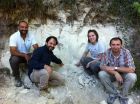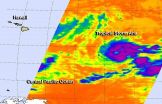(Press-News.org) A new study, published online in the journal Age and Ageing today, shows that the homebound status of adults over the age of 65 in the aftermath of the 2011 Great East Japan Earthquake is still a serious public health concern. Of 2,327 older adults surveyed, approximately 20% were found to be homebound.
A team of researchers led by Naoki Kondo of the University of Tokyo's School of Public Health studied data from the city of Rikuzentakata, an area that was seriously damaged by the disaster. Of its total population of 23,302 before the events of 2011, 1,773 people died or are still missing. Of 7,730 houses, 3,368 (43.6%) were affected with 3,159 "completely destroyed". Much of the population had been concentrated in flat coastal areas, and since the community infrastructure was totally shattered, many people who lost their houses insisted on moving to areas in the mountains.
This study used home-visit interviews with 2,327 adults over 65 years old (1027 men; 1300 women), and was carried out between August 2012 and October 2013. Interviewers gathered information of current morbidity, socio-economic status, health behaviour (diet, smoking, and alcohol intake), frequency of going out, and social support. 19.6% of men and 23.2% of women were shown to be homebound, defined as only leaving the house every 4 or more days. Of those older adults who were classified as homebound, around 40% also had no contact with neighbours.
Information was also obtained on the locations of grocery stores, convenience stores, and shopping centres from the online community directory database in August 2012. Information on shopper bus stops and hawker sites was provided by a disaster support team, and the team also collated road network data. This geographical analysis indicated that distances to retail stores was associated with the risk of people being homebound.
Lead author Naoki Kondo says: "This study has important implications for public health, especially in the setting of post-disaster community reconstruction. First, community diagnoses in a post-disaster setting should cover the built environment, including access to shopping facilities. Second, to prevent older victims of a disaster such as the Great East Japan Earthquake being homebound, it is clearly essential to provide access to the facilities that fulfil their daily needs.
"Given the findings of this study, such access could be increased by the private sector, suggesting the importance of public-private partnerships for post-disaster reconstruction."
INFORMATION:
Key messages:
The homebound status of older victims of the 2011 Great East Japan Earthquake is a matter of public health concern
Geographical analysis indicated that distances to retail stores was associated with the risk of people being homebound
Hawker and shopping bus services contributed to improved access, providing more opportunities for going out
Many older adults still homebound after 2011 Great East Japan Earthquake
2014-10-15
ELSE PRESS RELEASES FROM THIS DATE:
Can big data make sense of climate change?
2014-10-14
New Rochelle, October 14, 2014 –Big Data analytics are helping to provide answers to many complex problems in science and society, but they have not contributed to a better understanding climate science, despite an abundance of climate data. When it comes to analyzing the climate system, Big Data methods alone are not enough and sound scientific theory must guide data modeling techniques and results interpretation, according to an insightful article in Big Data, the highly innovative, peer-reviewed journal from Mary Ann Liebert, Inc., publishers. The article is available ...
Dinosaur breathing study shows that noses enhanced smelling and cooled brain
2014-10-14
ATHENS, Ohio (Oct. 14, 2014)—It's been millions of years since T. rex took its last breath, but a team led by Ohio University scientists is breathing life back into dinosaurs using high-powered computer simulations to model airflow through dinosaur snouts. The research has important implications for how dinosaurs used their noses to not only breathe but to enhance the sense of smell and cool their brains.
"Dinosaurs were pretty 'nosy' animals," said Ohio University doctoral student Jason Bourke, lead author of the new study published today in the Anatomical Record. ...
Mars One -- and done?
2014-10-14
In 2012, the "Mars One" project, led by a Dutch nonprofit, announced plans to establish the first human colony on the Red Planet by 2025. The mission would initially send four astronauts on a one-way trip to Mars, where they would spend the rest of their lives building the first permanent human settlement.
It's a bold vision — particularly since Mars One claims that the entire mission can be built upon technologies that already exist. As its website states, establishing humans on Mars would be "the next giant leap for mankind."
But engineers at MIT say the project ...
New sequencing reveals genetic history of tomatoes
2014-10-14
This week, an international team of researchers, led by the Chinese Academy of Agricultural Sciences in Beijing, published in the journal Nature Genetics a brief genomic history of tomato breeding, based on sequencing of 360 varieties of the tomato plant.
The C.M. Rick Tomato Genetics Resource Center at UC Davis played an important role in this study by providing seed of both cultivated tomato varieties and related wild species.
This study, which builds on the first tomato genome sequence completed just two years ago, shows in great detail how the processes of early ...
Photopharmacology: Optical control of insulin secretion
2014-10-14
Researchers at Ludwig-Maximilians-Universitaet (LMU) in Munich have chemically modified an anti-diabetic agent so as to make its action dependent on light. The resulting prototype compound, termed JB253, induces release of insulin only when pancreas cells are exposed to blue light.
Synthetic, light-sensitive, molecular switches can be utilized to control biochemical signaling processes in living cells. In a new study, a research team led by LMU Professor Dirk Trauner (Chemical Biology and Genetics) and his colleague Johannes Broichhagen, in collaboration with Prof. Guy ...
Earth's magnetic field could flip within a human lifetime
2014-10-14
Imagine the world waking up one morning to discover that all compasses pointed south instead of north.
It's not as bizarre as it sounds. Earth's magnetic field has flipped – though not overnight – many times throughout the planet's history. Its dipole magnetic field, like that of a bar magnet, remains about the same intensity for thousands to millions of years, but for incompletely known reasons it occasionally weakens and, presumably over a few thousand years, reverses direction.
Now, a new study by a team of scientists from Italy, France, Columbia University ...
House fly genome reveals expanded immune system
2014-10-14
ITHACA, N.Y. – Scientists have sequenced the house fly genome for the first time, revealing robust immune genes, as one might expect from an insect that thrives in pathogen-rich dung piles and garbage heaps.
The research, published Oct. 14 in the journal Genome Biology, will increase understanding of house fly genetics and biology and of how flies quickly adapt to resist insecticides, which could lead to novel control methods.
Adult house flies (Musca domestica) carry and transmit more than 100 human and animal diseases, including salmonellosis, anthrax, typhoid ...
NASA's Aqua satellite spots Central Pacific's Tropical Storm Ana
2014-10-14
NASA's Aqua satellite passed over Tropical Storm Ana on Monday, Oct. 13 after it formed in the Central Pacific Ocean.
Ana formed on Oct. 13 at 5 p.m. EDT (11 a.m. HST) as Tropical Depression 2-C, about 920 miles (1,480 km) east-southeast of Hilo, Hawaii. By 9 p.m. EDT that day, the depression had strengthened into Tropical Depression Ana.
NASA's Aqua satellite passed over Tropical Storm Ana on Monday, Oct. 13 at 11:11 UTC (7:11 a.m. EDT) and the Atmospheric Infrared Sounder or AIRS instrument gathered infrared data that showed some strong thunderstorms and cold cloud ...
1934 drought was worst of the last millennium, study finds
2014-10-14
WASHINGTON, DC— The 1934 drought was by far the most intense and far-reaching drought of the last 1,000 years in North America, and was caused in part by an atmospheric phenomenon that may have also led to the current drought in California, according to a new study.
New research finds that the extent of the 1934 drought was approximately seven times larger than droughts of comparable intensity that struck North America between 1000 A.D. and 2005, and nearly 30 percent worse than the next most severe drought that struck the continent in 1580.
"We noticed that ...
Building a bridge from basic botany to applied agriculture
2014-10-14
One of the planet's leading questions is how to produce enough food to feed the world in an increasingly variable climate. The Food and Agriculture Organization of the United Nations predicts that food production must rise 70% over the next 40 years to feed a growing global population, and plants are one major component of the necessary rise in food production. Plants—grains, cereals, fruits, vegetables, and more—feed humans directly and indirectly by supporting livestock. Current research must tap into our knowledge of how plants work to develop more efficient ...




